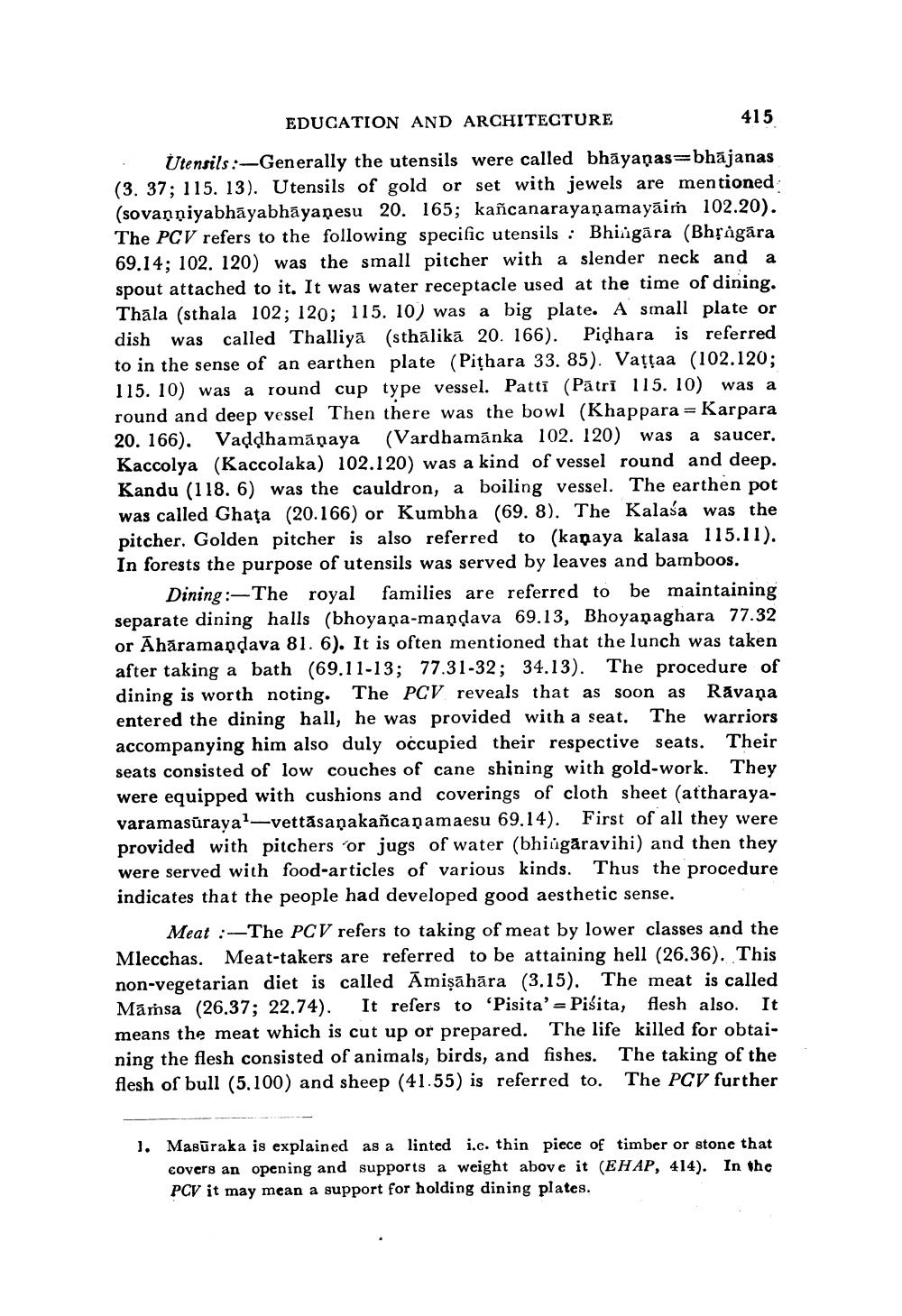________________
EDUCATION AND ARCHITECTURE
415
Utensils :-Generally the utensils were called bhāyaṇas=bhājanas (3. 37; 115. 13). Utensils of gold or set with jewels are mentioned (sovaņņiyabhāyabhāyaṇesu 20. 165; kañcanarayanamayāim 102.20). The PCV refers to the following specific utensils : Bhingāra (Bhịågāra 69.14; 102. 120) was the small pitcher with a slender neck and a spout attached to it. It was water receptacle used at the time of dining. Thāla (sthala 102; 120; 115. 10) was a big plate. A small plate or dish was called Thalliyā (sthālikā 20. 166). Pidhara is referred to in the sense of an earthen plate (Pithara 33. 85). Vațţaa (102.120; 115. 10) was a round cup type vessel. Patti (Pātri 115. 10) was a round and deep vessel Then there was the bowl (Khappara = Karpara 20. 166). Vaddhamāņaya (Vardhamānka 102. 120) was a saucer. Kaccolya (Kaccolaka) 102.120) was a kind of vessel round and deep. Kandu (118. 6) was the cauldron, a boiling vessel. The earthen pot was called Ghața (20.166) or Kumbha (69. 8). The Kalasa was the pitcher. Golden pitcher is also referred to (kapaya kalasa 115.11). In forests the purpose of utensils was served by leaves and bamboos.
Dining : The royal families are referred to be maintaining separate dining halls (bhoyaņa-mandava 69.13, Bhoyanaghara 77.32 or Āhāramapdava 81. 6). It is often mentioned that the lunch was taken after taking a bath (69.11-13; 77.31-32; 34.13). The procedure of dining is worth noting. The PCV reveals that as soon as Rāvana entered the dining hall, he was provided with a seat. The warriors accompanying him also duly occupied their respective seats. Their seats consisted of low couches of cane shining with gold-work. They were equipped with cushions and coverings of cloth sheet (attharayavaramasūraya? -vettasaņakañcanamaesu 69.14). First of all they were provided with pitchers or jugs of water (bhingäravihi) and then they were served with food-articles of various kinds. Thus the procedure indicates that the people had developed good aesthetic sense.
Meat :--The PCV refers to taking of meat by lower classes and the Mlecchas. Meat-takers are referred to be attaining hell (26.36). This non-vegetarian diet is called Amişāhāra (3.15). The meat is called Māṁsa (26.37; 22.74). It refers to Pisita' - Pisita, flesh also. It means the meat which is cut up or prepared. The life killed for obtaining the flesh consisted of animals, birds, and fishes. The taking of the flesh of bull (5,100) and sheep (41.55) is referred to. The PCV further
1. Masūraka is explained as a linted i.c. thin piece of timber or stone that
covers an opening and supports a weight above it (EHAP, 414). In the PCV it may mean a support for holding dining plates.




